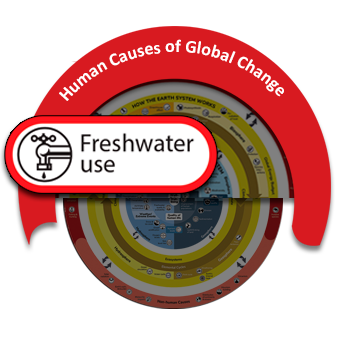Our need for freshwater requires the extraction of water from lakes, rivers, the ground, and man-made reservoirs for drinking, agriculture, recreation, and industrial processes. Population growth, especially over the last century, has increased global water use, and in turn, reduced freshwater availability in many regions, both for human consumption and for ecosystems. Additionally, global warming contributes to the frequency and severity of droughts in some regions, as warming changes atmospheric circulation patterns and the water cycle.

This diagram shows the water source (surface water or groundwater), and for what purposes the water was used in the United States in 2015. Credit: USGS
Human freshwater use impacts the Earth system in a variety of ways, including:
- Reducing regional biomass and productivity. Access to water is necessary for photosynthesis and for most organisms to survive. As water becomes limited species populations
- Restricting species ranges by decreasing the amount of water available for other organisms in ecosystems, which in turn alters species
- Altering erosion and sedimentation patterns, which also affects soil quality. For example, the diversion of stream water and the damming of rivers changes where and how much sedimentation occurs, which changes local habitats.
- The sinking of land (called subsidence) due to ground water extraction. The compaction of rock layers can also decrease the amount of ground water that an aquifer can hold.
Can you think of additional cause and effect relationships between freshwater use and other parts of the Earth system?
Visit the water cycle, precipitation, and freshwater quality and availability pages to explore more connections between the hydrosphere and other global changes.
